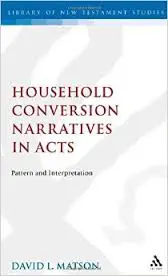

Household Conversion Narratives in Acts: Pattern & Interpretation
in Library of New Testament Studies
Pages
224
Publisher
Sheffield Academic Press
Published
1996
ISBN-13
9781850755869
Using features of the narrative-critical method, this book offers an innovative approach to a notable phenomenon in the book of Acts: the conversion of entire households to the Christian faith. When viewed against the household mission of the seventy(-two) messengers in Luke, the stories of Cornelius, Lydia, the Roman jailer and Crispus comprise a pattern of evangelistic activity that provides a common framework for their interpretation. Repetition and variation of the pattern offer important clues for the way each story functions within the wider context of Acts, opening up new lines of interpretation as well as new levels of unity/disunity between the Lukan writings.
Reviews
Household Conversion Narratives in Acts: Pattern and Interpretation JSNTSup 123 Sheffield: Sheffield Academic Press, 1996. Pp. 224, Hardcover, £ 43.00/$64.00, ISBN 1850755868. Robert L. Brawley McCormick Theological Seminary Chicago, IL 60637-1692 This monograph, originally submitted as a dissertation at Baylor University under Mikeal Parsons, breaks new ground by exploring household conversions as particular cases of the conversion narratives in Acts. It is also innovative in reading household conversions (1) in light of Jesus' instructions to the seventy-two in Luke 10 and (2) in light of Cornelius's conversion as paradigmatic for Acts. Zacchaeus comes in for special notice as a household conversion in which Jesus exemplifies what he instructs the seventy-two to do. This leaves three additional cases in Acts--Lydia, the Philippian jailer, and Crispus. Chapters on the mission of the seventy-two and Jesus to households in Luke set the stage for the discussion of household conversions in Acts. Matson devotes a special chapter to the Cornelius episode because he grants it paradigmatic significance. He investigates the conversions of Lydia, the Philippian jailer, and Crispus together in a fifth chapter, and adds a final chapter of conclusions. The method is a narrative criticism that interprets the text in its own story world as it is supplemented by cultural knowledge implicit in the story. Some readers will be surprised, therefore, when the author judges the sending of the seventy-two non-historical (p. 30) and infers that Acts reflects the conflict between church and synagogue after the temple's destruction (p. 177). Matson claims two particular departures from conventional approaches: (1) he adopts his teacher's proposal that Acts is a sequel to rather than a continuation of Luke; (2) he attempts to avoid abstracting conversion stories from their literary context. Readers, however, may raise the issue of abstracting with Matson in that he locates household conversion stories only in the thematic development of mission in Acts to the neglect of other thematic developments. This results in a missiologist ecclesiocentric reading.
[Full Review]
